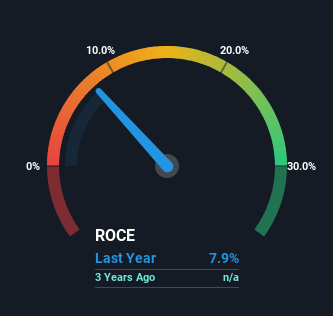- Japan
- /
- Professional Services
- /
- TSE:4015
Paycloud Holdings (TSE:4015) Might Have The Makings Of A Multi-Bagger
If you're not sure where to start when looking for the next multi-bagger, there are a few key trends you should keep an eye out for. Firstly, we'll want to see a proven return on capital employed (ROCE) that is increasing, and secondly, an expanding base of capital employed. Basically this means that a company has profitable initiatives that it can continue to reinvest in, which is a trait of a compounding machine. So on that note, Paycloud Holdings (TSE:4015) looks quite promising in regards to its trends of return on capital.
Understanding Return On Capital Employed (ROCE)
For those that aren't sure what ROCE is, it measures the amount of pre-tax profits a company can generate from the capital employed in its business. The formula for this calculation on Paycloud Holdings is:
Return on Capital Employed = Earnings Before Interest and Tax (EBIT) ÷ (Total Assets - Current Liabilities)
0.079 = JP¥440m ÷ (JP¥8.4b - JP¥2.9b) (Based on the trailing twelve months to November 2024).
Thus, Paycloud Holdings has an ROCE of 7.9%. In absolute terms, that's a low return and it also under-performs the Professional Services industry average of 16%.
Check out our latest analysis for Paycloud Holdings

Historical performance is a great place to start when researching a stock so above you can see the gauge for Paycloud Holdings' ROCE against it's prior returns. If you'd like to look at how Paycloud Holdings has performed in the past in other metrics, you can view this free graph of Paycloud Holdings' past earnings, revenue and cash flow.
What Can We Tell From Paycloud Holdings' ROCE Trend?
We're delighted to see that Paycloud Holdings is reaping rewards from its investments and is now generating some pre-tax profits. Shareholders would no doubt be pleased with this because the business was loss-making two years ago but is is now generating 7.9% on its capital. In addition to that, Paycloud Holdings is employing 166% more capital than previously which is expected of a company that's trying to break into profitability. We like this trend, because it tells us the company has profitable reinvestment opportunities available to it, and if it continues going forward that can lead to a multi-bagger performance.
On a related note, the company's ratio of current liabilities to total assets has decreased to 34%, which basically reduces it's funding from the likes of short-term creditors or suppliers. This tells us that Paycloud Holdings has grown its returns without a reliance on increasing their current liabilities, which we're very happy with.
The Key Takeaway
In summary, it's great to see that Paycloud Holdings has managed to break into profitability and is continuing to reinvest in its business. And with a respectable 25% awarded to those who held the stock over the last three years, you could argue that these developments are starting to get the attention they deserve. So given the stock has proven it has promising trends, it's worth researching the company further to see if these trends are likely to persist.
Paycloud Holdings does have some risks though, and we've spotted 3 warning signs for Paycloud Holdings that you might be interested in.
If you want to search for solid companies with great earnings, check out this free list of companies with good balance sheets and impressive returns on equity.
New: Manage All Your Stock Portfolios in One Place
We've created the ultimate portfolio companion for stock investors, and it's free.
• Connect an unlimited number of Portfolios and see your total in one currency
• Be alerted to new Warning Signs or Risks via email or mobile
• Track the Fair Value of your stocks
Have feedback on this article? Concerned about the content? Get in touch with us directly. Alternatively, email editorial-team (at) simplywallst.com.
This article by Simply Wall St is general in nature. We provide commentary based on historical data and analyst forecasts only using an unbiased methodology and our articles are not intended to be financial advice. It does not constitute a recommendation to buy or sell any stock, and does not take account of your objectives, or your financial situation. We aim to bring you long-term focused analysis driven by fundamental data. Note that our analysis may not factor in the latest price-sensitive company announcements or qualitative material. Simply Wall St has no position in any stocks mentioned.
About TSE:4015
Paycloud Holdings
Provides various technology solutions in Japan and internationally.
Excellent balance sheet and fair value.
Market Insights
Community Narratives



